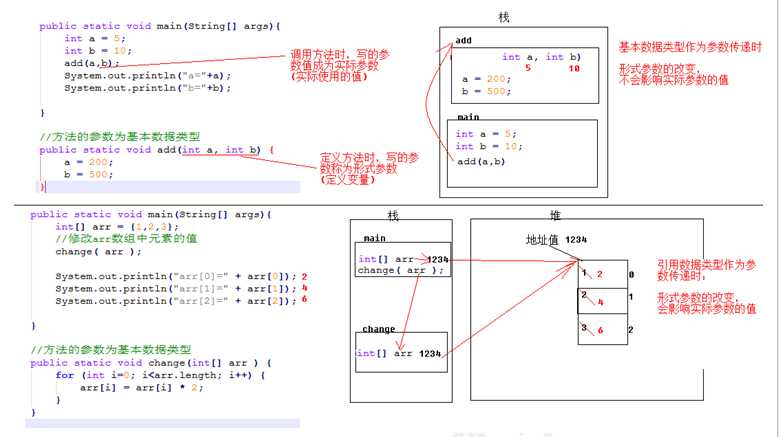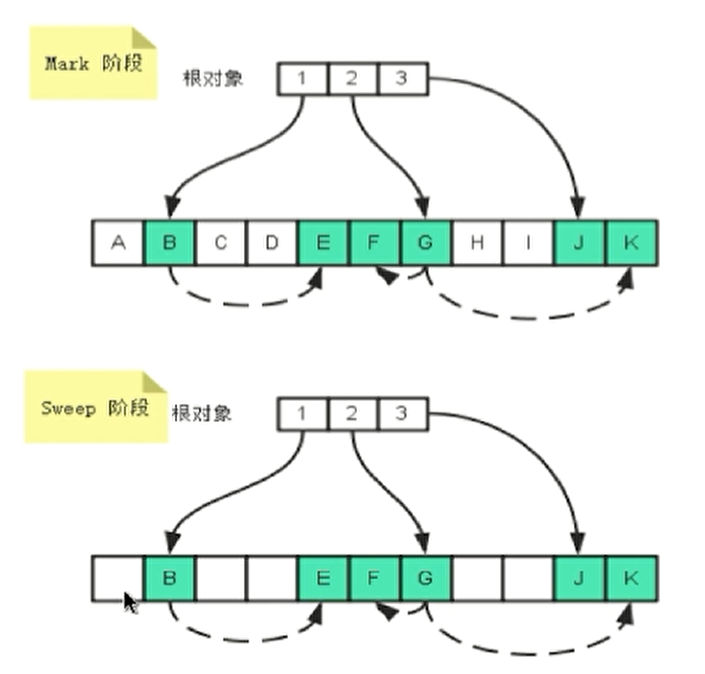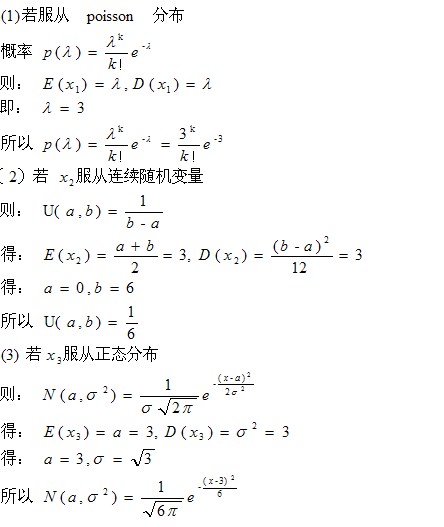Java方法
Java 中的方法是一组语句,它们组合在一起以执行各种操作。例如,当调用 .out.() 方法时,系统实际上会执行多个语句,以便在控制台上显示消息。
了解如何创建自己的带或不带返回值的方法,调用带或不带参数的方法,以及在编程中应用方法抽象。
1. 创建方法
让我们看一下该方法的语法 -
public static int methodName(int a, int b) {
// body
}
在上面的语法中,
方法定义由方法头和方法体组成。以下语法中显示了相同的内容 -
modifier returnType nameOfMethod (Parameter List) {
// method body
}
上面显示的语法包括 -
例子
min() 方法在以下代码中定义。此方法接受两个 int 类型的参数:num1 和 num2,并返回两者之间的最大值 -
/** 返回两个数字之间的最小值 */
public static int minFunction(int n1, int n2) {
int min;
if (n1 > n2)
min = n2;
else
min = n1;
return min;
}
2. 方法调用
方法可以通过调用方法来使用,可以通过两种方式调用,即方法有返回值或不返回任何值。
方法调用的过程很简单。当程序调用一个方法时,程序控制转移到被调用的方法。这个被调用的方法然后在两种情况下将控制权返回给调用者,即 -
调用返回 void 的方法 -
System.out.println("This is Yiibai.com!");
调用具有返回值的方法 -
int result = sum(6, 9);
以下是显示如何定义方法以及如何调用它的示例 -
public class ExampleMinNumber {
public static void main(String[] args) {
int a = 111;
int b = 125;
int c = getMin(a, b);
System.out.println("最小值 = " + c);
}
/** 返回两个 int 数值的最小值 */
public static int getMin(int n1, int n2) {
int min;
if (n1 > n2)
min = n2;
else
min = n1;
return min;
}
}
执行上面的示例代码,得到如下结果:
最小值 = 111
3. 无效关键字
void 关键字允许创建不返回值的方法。在下面的示例中,有一个返回 void 的方法,它不返回任何值。调用 void 方法必须是一个语句方法,即 (245.67);。它是一个以分号结尾的 Java 语句,如下例所示 -
public class ExampleVoid {
public static void main(String[] args) {
methodRankPoints(245.67);
}
public static void methodRankPoints(double points) {
if (points >= 202.5) {
System.out.println("Rank:A1");
}else if (points >= 122.4) {
System.out.println("Rank:A2");
}else {
System.out.println("Rank:A3");
}
}
}

执行上面的示例代码,得到如下结果:
Rank:A1
4. 按值传递参数
按值传递参数时需要传递参数。它们应该与方法规范中的参数顺序相同。参数可以通过值或引用传递。
传值传参就是调用带参数的方法。通过这样做,参数值将传递给参数。
例子
以下程序显示了按值传递参数的示例。即使在方法调用之后,参数的值也保持不变。
public class swappingExample {
public static void main(String[] args) {
int a = 30;
int b = 45;
System.out.println("Before swapping, a = " + a + " and b = " + b);
// 调用交换方法
swapFunction(a, b);
System.out.println("Now, Before and After swapping values will be same here:");
System.out.println("After swapping, a = " + a + " and b is " + b);
}
public static void swapFunction(int a, int b) {
System.out.println("Before swapping(Inside), a = " + a + " b = " + b);
// 交换 n1 和 n2
int c = a;
a = b;
b = c;
System.out.println("After swapping(Inside), a = " + a + " b = " + b);
}
}
执行上面的示例代码,得到如下结果:
Before swapping, a = 30 and b = 45
Before swapping(Inside), a = 30 b = 45
After swapping(Inside), a = 45 b = 30
Now, Before and After swapping values will be same here:
After swapping, a = 30 and b is 45
5. 方法重载
当一个类有两个或多个同名但参数不同的方法时,称为方法重载。这和重写不一样。在覆盖中,方法具有相同的方法名称、类型、参数数量等。
在前面讨论的查找最小整数类型的示例中,假设您要查找两种类型中的最小数值。可以引入重载的概念来创建两个或多个同名但参数不同的方法。
请参阅以下示例代码 -
public class ExampleOverloading {
public static void main(String[] args) {
int a = 11;
int b = 6;
double c = 7.3;
double d = 9.4;
int result1 = getMin(a, b);
// 具有相同函数名称,但数字不同参数
double result2 = getMin(c, d);
System.out.println("Minimum Value = " + result1);
System.out.println("Minimum Value = " + result2);
}
// 处理 int 类型的数值(方法重载)
public static int getMin(int n1, int n2) {
int min;
if (n1 > n2)
min = n2;
else
min = n1;
return min;
}
// 处理 double 类型的数值(方法重载)
public static double getMin(double n1, double n2) {
double min;
if (n1 > n2)
min = n2;
else
min = n1;
return min;
}
}
执行上面的示例代码,得到如下结果:
Minimum Value = 6
Minimum Value = 7.3
重载的方法使程序可读。在这里,这两个方法以相同的名称给出,但具有不同的参数类型。结果是找到最少数量的类型 int 和 type。
6. 使用命令行参数
有时希望在程序运行时将一些信息传递给程序。它通过将命令行参数传递给 main() 来做到这一点。
命令行参数是执行时直接在命令行上跟随程序名称的信息。在 Java 程序中访问命令行参数非常简单。它们作为字符串存储在传递给 main() 的类型化数组中。
例子
以下程序显示传递给程序的所有命令行参数 -
public class CommandLine {
public static void main(String args[]) {
for(int i = 0; i使用以下方法执行此过程 -

C:/> java CommandLine this is a command line 200 -100
然后你会得到以下结果:
args[0]: this
args[1]: is
args[2]: a
args[3]: command
args[4]: line
args[5]: 200
args[6]: -100
7. 这个关键字
this 是 Java 中的一个关键字,在实例方法或构造函数中用作对当前类对象的引用。用它来引用类的成员,例如:构造函数、变量和方法。
注意 - 此关键字仅用于实例方法或构造函数。
通常方法, this 关键字用于 -
以下是使用此关键字访问类成员的示例 -
public class ThisExample {
// 实例变量:num
int num = 10;
ThisExample() {
System.out.println("This is an example program on keyword this");
}
ThisExample(int num) {
// 调用默认构造方法
this();
// 将局部变量 num 分配给实例变量 num
this.num = num;
}
public void greet() {
System.out.println("Hi Welcome to Yiibai");
}
public void print() {
// 局部变量:num
int num = 20;
// 打印局部变量
System.out.println("value of local variable num is : "+num);
// 打印实例变量
System.out.println("value of instance variable num is : "+this.num);
// 调用类方法
this.greet();
}
public static void main(String[] args) {
// 实例化该类
ThisExample obj1 = new ThisExample();
// 调用 print 方法
obj1.print();
//通过参数化构造函数将新值传递给 num 变量
ThisExample obj2 = new ThisExample(30);
// 再次调用 print 方法
obj2.print();
}
}
执行上面的示例代码,我们得到以下结果 -
This is an example program on keyword this
value of local variable num is : 20
value of instance variable num is : 10
Hi Welcome to Yiibai
This is an example program on keyword this
value of local variable num is : 20
value of instance variable num is : 30
Hi Welcome to Yiibai
8. 变量参数 (var-args)
JDK 1.5 允许将可变数量的相同类型的参数传递给方法。该方法中的参数声明如下 -
typeName... parameterName
在方法声明中,指定类型,后跟省略号 (...)。一个方法中只能指定一个变长参数,并且该参数必须是最后一个参数。
public class VarargsDemo {
public static void main(String args[]) {
// 使用变量参数调用方法
printMax(314, 321, 213, 212, 356.5);
printMax(new double[]{1, 2, 3});
}
public static void printMax( double... numbers) {
if (numbers.length == 0) {
System.out.println("No argument passed");
return;
}
double result = numbers[0];
for (int i = 1; i < numbers.length; i++)
if (numbers[i] > result)
result = numbers[i];
System.out.println("参数列表中的最大值是:" + result);
}
}
执行上面的示例代码,我们得到以下结果 -
参数列表中的最大值是:356.5
参数列表中的最大值是:3.0
9. () 方法
() 方法在垃圾收集器对象最终被销毁之前调用,它可以用来确保对象被完全终止。例如,() 可用于确保关闭此对象拥有的打开文件。
要将终结器添加到类中,只需定义 () 方法。每当 Java 方法想要回收该类的对象时,都会调用此方法。
在 () 方法中,您将指定在销毁对象之前必须执行的操作。() 方法具有这种一般形式 -
protected void finalize( ) {
// finalization code here
}
在这里,关键字是一个修辞字符,它阻止通过类外部定义的代码访问 ()。
我们无法知道 Java 何时甚至是否会执行 the() 方法。如果程序在垃圾回收发生之前结束,() 将不会执行。












